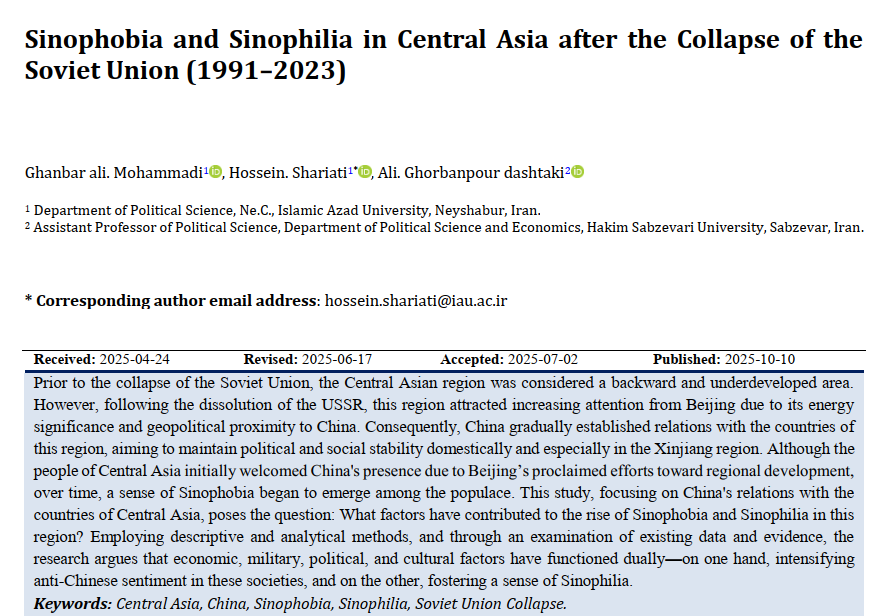Sinophobia and Sinophilia in Central Asia after the Collapse of the Soviet Union (1991–2023)
Keywords:
Central Asia, China, Sinophobia, Sinophilia, Soviet collapse.Abstract
Prior to the collapse of the Soviet Union, the Central Asian region was considered a backward and underdeveloped area. However, following the dissolution of the USSR, this region attracted increasing attention from Beijing due to its energy significance and geopolitical proximity to China. Consequently, China gradually established relations with the countries of this region, aiming to maintain political and social stability domestically and especially in the Xinjiang region. Although the people of Central Asia initially welcomed China's presence due to Beijing’s proclaimed efforts toward regional development, over time, a sense of Sinophobia began to emerge among the populace. This study, focusing on China's relations with the countries of Central Asia, poses the question: What factors have contributed to the rise of Sinophobia and Sinophilia in this region? Employing descriptive and analytical methods, and through an examination of existing data and evidence, the research argues that economic, military, political, and cultural factors have functioned dually—on one hand, intensifying anti-Chinese sentiment in these societies, and on the other, fostering a sense of Sinophilia.
Downloads
References
Allen, K., Saunders, P. C., & Chen, J. (2017). Chinese Military Diplomacy, 2003-2016: Trends and Implications. National Defense University Press.
Azizi, H. (2014). China's Soft Power in Central Asia: Approaches, Tools, and Objectives. Quarterly Journal of Central Asia and Caucasus Studies(88).
Billé, F. (2015). Sinophobia: Anxiety, Violence, and the Making of Mongolian Identity. https://doi.org/10.21313/hawaii/9780824839826.001.0001
Brown, K. (2017). The critical Transition: China Priorities for 2012. The Royal Institute of International Affair.
Callahan, W. (2017). Dreaming as a critical discourse of national belonging: China Dream, American Dream and world dream. Nations and Nationalism, 23(2), 248-270. https://doi.org/10.1111/nana.12296
Chase, M., Garafola, C. L., & Beauchamp-Mustafaga, N. (2017). Chinese Perceptions of and Responses to US Conventional Military Power. Asian Security. https://doi.org/10.1080/14799855.2017.1301931
Ekman, A. (2015). China in Asia what is behind the New Silk Roads? Institute of International Relations (Ifri) and OCP Policy Center.
Feyzi, K. (2011). The uprising of Sheikh Obaidullah Shamzini during the reign of Naser al-Din Shah Qajar. Ilam: Jouhar Hayat.
Greer, T. (2018). one belt, one road, one big mistake. https://foreignpolicy.com/2018/12/06/bri-china-belt-road-initiative-blunder/
He, J., He, K., & Linlin, W. (2017). Transnational China in 21st Century. Bookboon the eBook Company.
International Crisis Group. (2017). Central Asias Silk Road Rivalries. https://www.crisisgroup.org/europe-central-asia/central-asia/245-central-asias-silk-road-rivalries
Kagan, R. (2008). The return of History and the end of Dreams. Alfred A.Knopf.
Karami, J., & Azizi, H. (2013). China's Security Relations with Central Asia: From Security Links to Regional Security Complex. Central Eurasian Studies(12).
Laruelle, M. (2012). The Chinese Question in Central Asia :Domestic Order, Social Change, and the Chinese Factor. https://www.hurstpublishers.com/book/the-chinese-question-in-central-asia/
Mihalka, M. (2007). Not Much of a Game: Security Dynamics in Central Asia. China and Eurasia Quarterly, 5(2). http://www.silkroadstudies.org/new/docs/CEF/Quarterly/May_2002
Peyrouse, S. (2012). Understanding Sinophobia in Central Asia. https://thediplomat.com/2019/10/why-is-anti-chinese-sentiment-on-the-rise-in-central-asia/
Peyrouse, s. (2016). Discussing china:sinophobia and sinophilia in central asia. Journal of Eurasian StudiesVL - 7, 14-23. https://doi.org/10.1016/j.euras.2015.10.003
Shah Mansouri, T. M., & Shamiri, A. (2010). China's Goals and Interests in Central Asia After September 11: From Cooperation and Neighborliness to International Economic Diplomacy. Quarterly Journal of Central Asia and Caucasus Studies(96).
Shahandeh, B. (2016). Dreams of 2049: Challenges Ahead in Transforming China into a Full-Fledged Power. Hamshahri Diplomatic(90), 30-33.
Shapiro, D. M. (2019). China and Russia central asia tricky balance. https://www.russiamatters.org/blog/china-and-russia-central-asia-tricky-balance
Sipri. (2017). Trends in world military expenditure, 2016. https://www.sipri.org/sites/default/files/Trends-world-militaryexpenditure-2016.pdf
Stronsky, P. (2018). on central asias big questions. https://carnegieendowment.org/2018/11/20/on-central-asia-s-big-questions-pub-77766
Sutter, R. (2008). Durability in China's Strategy toward Central Asia - Reasons for Optimism. China and Eurasia Forum Quarterly, 6(1).
Talebi Arani, R. (2016). Reflections on China's Economy-Oriented Foreign Policy at the Beginning of the 21st Century. Research Center of the Iranian Parliament.
Tasnim News, A. (2019a). China and Russia Competing for Influence in Kyrgyzstan. https://www.tasnimnews.com/fa/news/1398/01/21/1985442
Tasnim News, A. (2019b). China Seeking Military Bases in Central Asia. https://www.tasnimnews.com/fa/news/1398/01/18/1982994
Tasnim News, A. (2019c). President of Kyrgyzstan: Those Trying to Damage Our Relations with China Will Not Succeed. https://www.tasnimnews.com/fa/news/1397/10/22/1919857
Umirbekov, D. (2019). Kazakhstan: Sinophobic sentiments trigger fresh rallies. https://eurasianet.org/kazakhstan-sinophobic-sentiments-trigger-fresh-rallies
UranKyzy, A. (2019). why-is-anti-chinese-sentiment-on-the-rise-in-central-asia. https://thediplomat.com/2019/10/why-is-anti-chinese-sentiment-on-the-rise-in-central-asia/
Vercuiel, J. (2018). Taming the Bear while Riding the Dragon? Central Asia confronts Russian and Chinese economic influences. https://doi.org/10.4000/regulation.13626
Waltz, K. (1979). Theory of International Politics. McGraw-Hill.
Zuenko, I. (2018). the-balance-between-sinophobia-and-discourse-on-cooperation-expert-opinion-on-china-in-russia-and-kazakhstan. http://www.theasanforum.org/the-balance-between-sinophobia-and-discourse-on-cooperation-expert-opinion-on-china-in-russia-and-kazakhstan/

Downloads
Additional Files
Published
Submitted
Revised
Accepted
Issue
Section
License
Copyright (c) 2025 Ghanbar ali Mohammadi (Author); Hossein Shariati (Corresponding author); Ali Ghorbanpour dashtaki (Author)

This work is licensed under a Creative Commons Attribution-NonCommercial 4.0 International License.





